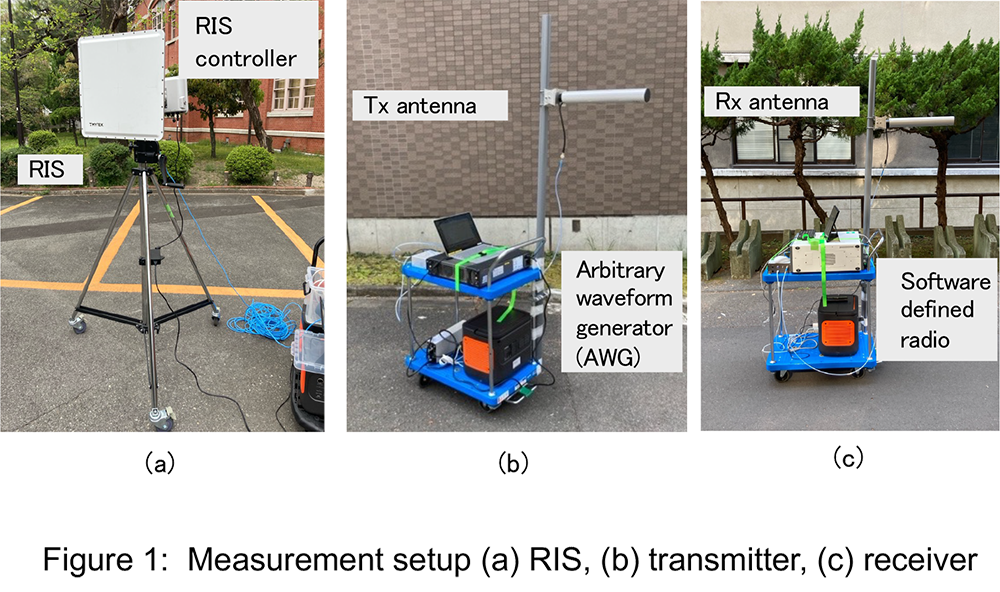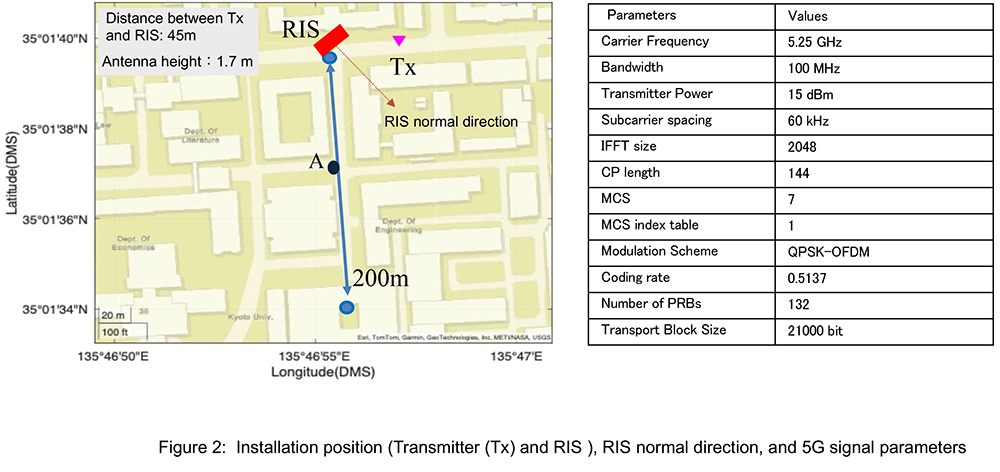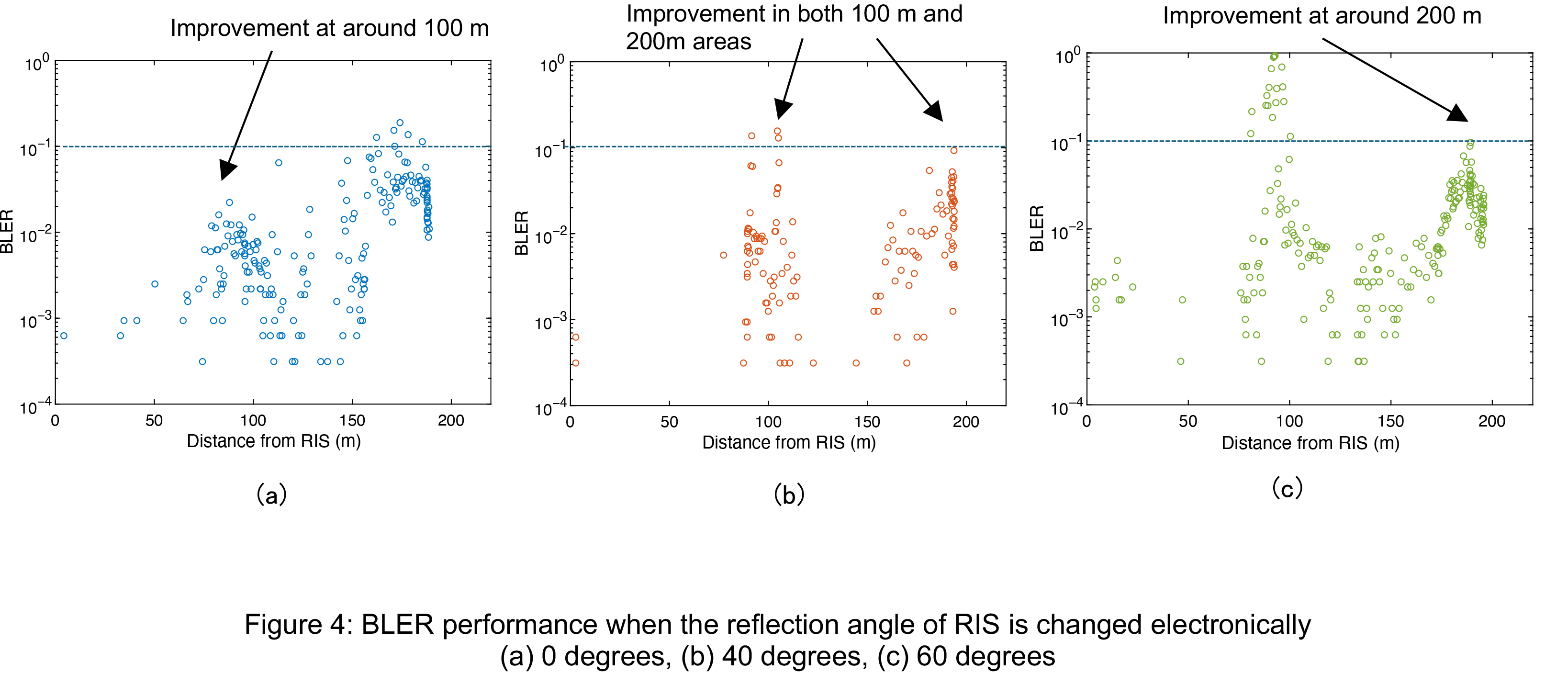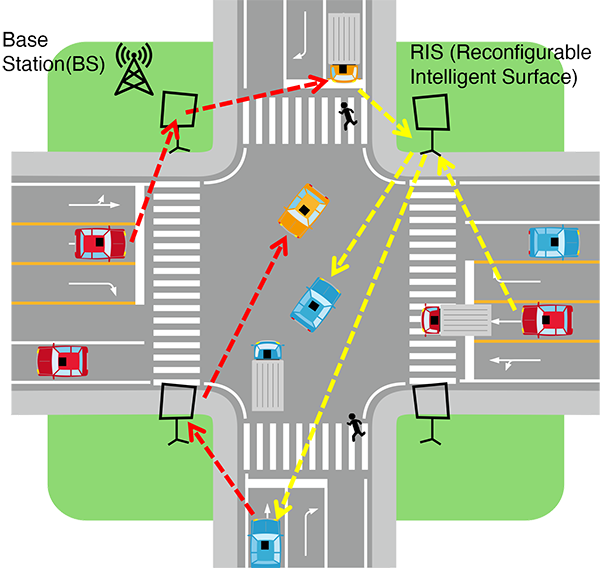






[Home] » [Press Release]
Successful basic transmission of a Vehicle-to-Vehicle communication system using 5G signal and 5GHz-RIS in Intersection Environment
-Extends communication area even in environments with low radio diffraction to prevent accidents between vehicles.
|
A research laboratory led by Professor Hiroshi Harada of the Graduate School of Informatics, Kyoto University, has been investigating the use of an reconfigurable intelligent surface (RIS) , which can dynamically control the direction of radio wave reflection, to expand the communication area of a vehicle-to-everything (V2X) communication system using the 5 GHz band, which has low radio wave diffraction in environments outside of intersection sight lines. We conducted a basic transmission experiment using RIS operating in the 5 GHz band to transmit 5G signals in an outdoor environment and succeeded in expanding the non-line-of-sight transmission characteristics by a factor of nearly four. The results of this experiment made it possible to transmit information from a vehicle to other vehicles easily and over a wide area in an intersection non-line-of-sight environment, without the need for repeaters, etc., which are necessary for transmission and reception. This is expected to promote research and development related to the construction of cooperative communication networks for safety and security at intersections for automated driving and automated driving support.
|

|
1. Background
With the commercial launch of the fifth generation of mobile communications (5G), a large number of "things" in addition to people are being connected to the internet using 5G systems. In the field of automated driving and support systems, V2X (vehicle-to-everything) technology is attracting particular attention, and its use with 5G systems is being considered. In this system, vehicles traveling through intersections share information with each other, such as their locations and data from sensors, meters, and monitors installed at the intersection. This contributes to solving transportation problems, such as reducing traffic accidents. Currently, Japan is considering allocating the 5.9 GHz frequency for vehicle-to-vehicle communication. Compared to the UHF band, the 5 GHz band propagates radio waves more directly, necessitating the use of roadside relays for non-line-of-sight communications. However, relaying requires receiving the signal and reallocating resources, such as time and frequency, before transferring it. Therefore, a method that enables low latency and an extended communication range in an obstructed environment must be considered.
2. Research Results
To expand the communication area of a vehicle-to-vehicle communication system operating in the 5 GHz band — which has low radio wave diffraction in a non-line-of-sight crossing environment and low latency — we investigated the use of a reconfigurable intelligent surface (RIS). The RIS can dynamically control the direction of radio wave reflection using an electrical element that can change its reflective properties. We conducted a basic transmission experiment using an RIS operating in the 5 GHz band to transmit 5G signals in an outdoor environment. We succeeded in expanding the non-line-of-sight transmission characteristics by nearly four times.
The following four main points were implemented in the transmission experiment:
- RIS, which is available in the 5 GHz band (Figure 1(a)), was installed. Additionally, a transmitter and a receiver, both of which are capable of generating 5G signals with a bandwidth of 100 MHz, were developed and installed individually on a cart (Figure 1(b): transmitter; Figure 1(c): receiver).
- A transmitter was installed in an outdoor environment that simulated an intersection, and the transmission characteristics of the 5G signal in a non-line-of-sight environment were acquired by moving the transmitter on a cart through an area assumed to be non-line-of-sight.
- Transmission characteristics of 5G signals in a non-line-of-sight environment were obtained when the transmitter and RIS were installed in an outdoor environment that simulated an intersection environment and the RIS power was turned off.
- Transmission characteristics of 5G signals in a non-line-of-sight environment were obtained with the transmitter and RIS installed in an outdoor intersection environment, the RIS power turned on, and the RIS reflection angle dynamically controlled at 0, 40, and 60 degrees.

|

|
Figure 2 shows the transmitter parameters, the RIS installation location, the normal direction of the RIS, and the 5G signal. The RIS is 510 x 510 x 57 mm in size and has a gain of 44.6–46.2 dB. The transmitter and receiver antennas are Yagi antennas with a gain of 15 dBi and an antenna height of 1.7 meters.
Figure 3 shows the transmission characteristics with and without the RIS installed. In this case, the block error rate (BLER) of the 5G signal is used as the transmission characteristic. The required BLER value is 10⁻¹. With the RIS installed but with no electronic control of the RIS, the transmission distance triples to nearly 150 m due to normal reflection. However, significant degradation occurs around 100 m.
Next, turn on the RIS and change the angle of reflection to 0, 40, and 60 degrees relative to the normal direction of the reflector. 40 degrees is the direction along the road outside the non-line-of-sight from the RIS. Figure 4 shows that the RIS has mitigated the large deterioration that was visible at about 100 meters. It is interesting to note that when the RIS is reflected in the direction along the road outside the line of sight (40 degrees), the improvement is seen in both the 100m and 200m directions, indicating that the transmission distance is four times longer than without the RIS. Further improvement can be seen at 100m when the RIS reflection direction is set to 0 degrees, and at 200m when the RIS reflection direction is set to 60 degrees. By changing the direction of reflection of the RIS according to the usage scenario, there is a possibility that 5G signals can be transmitted to the necessary area with the necessary quality.

|
3. Expected effects, future plans
This achievement makes it possible to transmit information from a vehicle to other vehicles easily and over a wide area in an intersection non-line-of-sight environment, without the need for a repeater or other equipment that transmits and receives the information. It is expected to promote research and development on the construction of cooperative communication networks for safety and security at intersections for automated driving and automated driving support.
The details of this experiment was presented at the Institute of Electronics, Information and Communication Engineers (IEICE) Technical Conference in May.
https://ken.ieice.org/ken/paper/20250522zcK5/eng/
Moreover, Prof. Harada will also give a keynote speech
(K2-2, 11:30-12:30) at Wireless Japan, an exhibition specializing in wireless communications, to be held at Tokyo Big Sight on May 29.
https://prd.event-lab.jp/wj2025/seminar/program/ detail/4c76fe0877f72e21c5693c7ff1c3d319/WJWTP
4. Research projects
*A part of this research was conducted as part of a contract research project (JPJ010017C07501) sponsored by the National Institute of Information and Communications Technology (NICT).

|
Terminologies
» 1. V2X (Vehicle-to-everything)
V2X is a system that reduces various risks associated with vehicles by wirelessly connecting vehicles to other vehicles, infrastructure, pedestrians, networks, etc., and by sharing information and cooperating with each other. V2X consists of V2I (vehicle-to-infrastructure), which connects vehicles to infrastructure such as roadside equipment, V2P (vehicle-to-pedestrian), which connects vehicles to pedestrians, and V2N (vehicle-to-network), which connects vehicles to networks.
» 2. RIS (Reconfigurable Intelligent Surface)
This reflector is constructed using electrical elements that can change the reflective surface electrically, and can dynamically control the direction and characteristics of radio wave reflection.
» 3. 5G New-Radio (5G-NR)
It is a radio interface adopted in 5G and standardized by the international standardization organization 3GPP (3rd Generation Partnership Project). It enables flexible signal generation for various use cases.
[For research inquiries, contact]
|